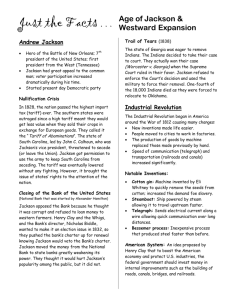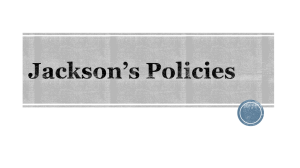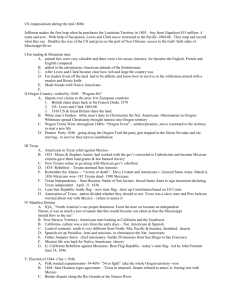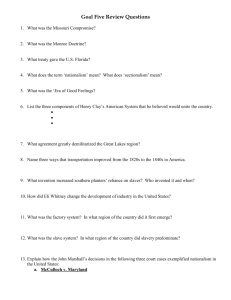Ch. 13 – The Age of Jackson Complete Notes
advertisement
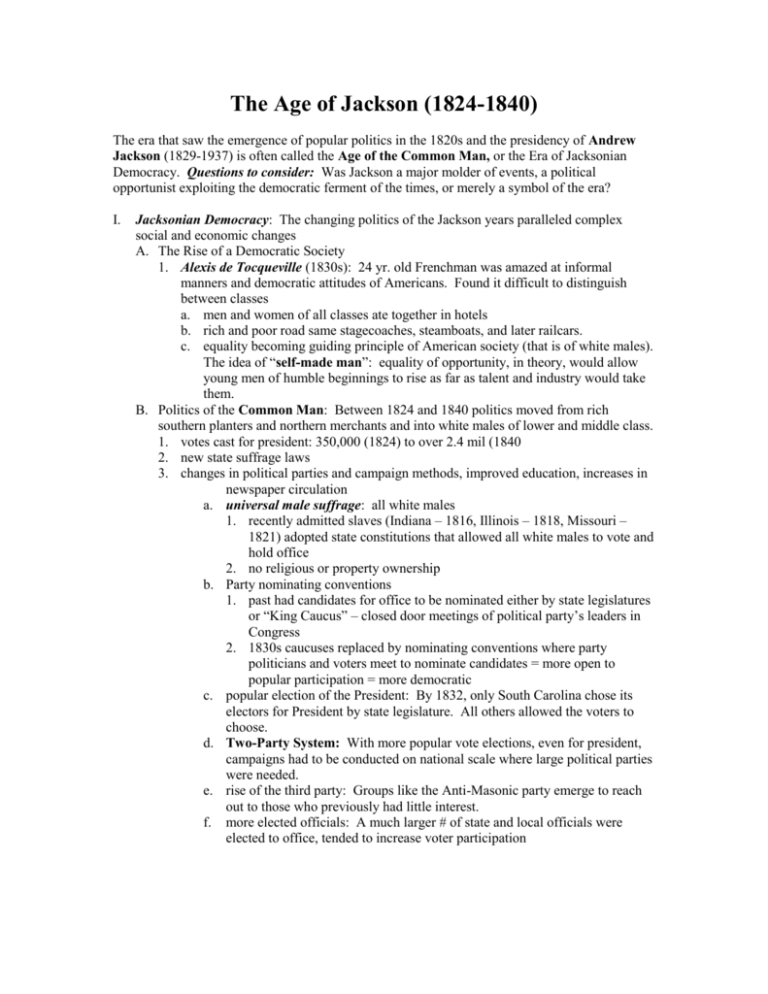
The Age of Jackson (1824-1840) The era that saw the emergence of popular politics in the 1820s and the presidency of Andrew Jackson (1829-1937) is often called the Age of the Common Man, or the Era of Jacksonian Democracy. Questions to consider: Was Jackson a major molder of events, a political opportunist exploiting the democratic ferment of the times, or merely a symbol of the era? I. Jacksonian Democracy: The changing politics of the Jackson years paralleled complex social and economic changes A. The Rise of a Democratic Society 1. Alexis de Tocqueville (1830s): 24 yr. old Frenchman was amazed at informal manners and democratic attitudes of Americans. Found it difficult to distinguish between classes a. men and women of all classes ate together in hotels b. rich and poor road same stagecoaches, steamboats, and later railcars. c. equality becoming guiding principle of American society (that is of white males). The idea of “self-made man”: equality of opportunity, in theory, would allow young men of humble beginnings to rise as far as talent and industry would take them. B. Politics of the Common Man: Between 1824 and 1840 politics moved from rich southern planters and northern merchants and into white males of lower and middle class. 1. votes cast for president: 350,000 (1824) to over 2.4 mil (1840 2. new state suffrage laws 3. changes in political parties and campaign methods, improved education, increases in newspaper circulation a. universal male suffrage: all white males 1. recently admitted slaves (Indiana – 1816, Illinois – 1818, Missouri – 1821) adopted state constitutions that allowed all white males to vote and hold office 2. no religious or property ownership b. Party nominating conventions 1. past had candidates for office to be nominated either by state legislatures or “King Caucus” – closed door meetings of political party’s leaders in Congress 2. 1830s caucuses replaced by nominating conventions where party politicians and voters meet to nominate candidates = more open to popular participation = more democratic c. popular election of the President: By 1832, only South Carolina chose its electors for President by state legislature. All others allowed the voters to choose. d. Two-Party System: With more popular vote elections, even for president, campaigns had to be conducted on national scale where large political parties were needed. e. rise of the third party: Groups like the Anti-Masonic party emerge to reach out to those who previously had little interest. f. more elected officials: A much larger # of state and local officials were elected to office, tended to increase voter participation g. popular campaigning: candidates directed campaigns to interests and prejudices of the common people 1. politics became a form of local entertainment 2. campaigns of 1830s and 1840s had parades, bands, and rallies with food and drink 3. candidates went “negative” to portray “non-common man” opponent h. Spoils System and rotation of officeholders 1. Jackson believed in appointing people to federal jobs if they actively campaigned for the Democratic party. Promoted government corruption 2. Jackson believed “one man was as good as any other” when it came to holding office. He would limit the term of a Democrat in office, then replace them with another II. Jackson v. Adams: Political change in the Jacksonian era began several years before Jackson moved into the White House. In the controversial election of 1824, Jackson won more popular votes than any other candidate, but lost the election. A. Election of 1824: The so-called “Era of Good Feelings” under Monroe ended in political bad feelings in 1824. By then, the old congressional caucus system or choosing presidential candidates had broken down. As a result, four candidates of the same party (the Republicans for by Jefferson) campaigned for presidency: John Quincy Adams, Henry Clay, William Crawford, and Andrew Jackson. 1. Jackson won greatest number of popular votes, but because the vote was split four ways, le lacked a majority in the electoral college as required by the Constitution. 2. House of Representatives had to choose from the top three 3. Clay used influence in the House to get JQ Adams elected and in turn, Adams made Clay his Secretary of State 4. Jackson’s group called it a “corrupt bargain.” B. President J.Q. Adams 1. Further alienated followers of Jackson when he asked Congress for $ for internal improvements, aid to manufacturing, and even a national university and astrological observatory 2. Jacksonians viewed all as a waste and a violation of Constitution 3. By 1828, Adams was able to piece together a new tariff law that generally satisfied northern manufacturers but alienated southern planters, who denounced it as a “tariff of abominations.” C. The Revolution of 1828: Adams seeks re-election 1. Jacksonians used discontent of southerners and westerners and new campaign tactics of party organization to sweep “Old Hickory” into office 2. beyond bbqs, parades, Jackson smeared the president, accusing Adams’ wife of being born out of wedlock. Adams’s camp responded in kind, accusing Jackson’s wife of adultery. 3. Mudslinging works – 3x number of voters of 1824 4. Jackson won handily as his reputation as a war hero and man of western frontier meant more than his stance on issue. III. Presidency of Andrew Jackson: Different kind of guy than others, symbol of emerging working class and middle class, or “common man.” Born in a frontier log cabin, Jackson attained military fame (Battle of New Orleans) and came to live in a mansion in Tennessee (Hermitage) as a wealthy planter and slaveowner. Chewed tobacco, fought several duels, and had a violent temper. First president since Washington with out a college education.☺ A. Role of the President: presented himself as the representative of all people and protector of common men against the abuses of power by the rich and privileged. 1. opposed increasing federal spending and national debt 2. interpreted the powers of Congress narrowly and vetoed more bills (12) than all six former presidents combined. 3. vetoed the use of federal $ to build the Maysville Road because it was wholly within Kentucky, home of Jackson’s rival, Henry Clay. 4. Kitchen Cabinet: Advisors who were not in his official cabinet, members of appointed cabinet had less influence B. Peggy Eaton Affair: Also fighting for “common woman”. Peggy O’Neal Eaton (wife of Secretary of Treasury) was target of malicious gossip by other cabinet wives, much as his recently deceased wife had been in the 1828 campaign. They refused to invite her to private parties because they suspected that she was an adultress. 1. Jackson tried to force cabinet wives to accept her, but most of the Cabinet resigned along with Jackson’s VP John C. Calhoun a year later 2. For remaining loyal, Martin Van Buren (NY) was chosen as new VP C. Indian Removal Act (1830): Jackson sympathized with land hungry whites who wanted Native American lands 1. Most “humane” solution was to compel Native Americans to leave traditional homelands and resettle west of the Mississippi River. 2. Signed law which forced resettlement of many thousands. By 1835, most eastern tribes had been reluctantly moved. 3. 1836 – Bureau of Indian Affairs was created to “assist” resettled tribes. 4. Cherokee Nation V. Georgia (1831): Supreme Court ruled that Cherokee were not a foreign nation with the right to sue in federal court. 5. Worcester v. Georgia (1832): Supreme Court ruled that laws of Georgia had no force within the boundaries of Cherokee Nation. a. Jackson sided with the states: “John Marshall had made his decision, now let him enforce it.” b. 1838: After Jackson was out of office, U.S. army forced 15,000 Cherokee to leave Georgia on the Trail of Tears (4,000 die) D. Nullification Crisis: Jackson favored states’ rights but not at the expense of possible disunion. 1. 1828: South Carolina declared the “Tariff of Abominations” to be null and void, in accordance to Calhoun’s Nullification Theory. 2. 1830 – Daniel Webster (Mass) v. Robert Haynes (South Carolina) where Webster attached the idea that any state could defy or leave the Union. 3. Jackson, “Our federal Union, it must be preserved.” Calhoun, “The Union, next to our liberties, most dear.” Rough and awkward dinner! 4. 1832 – South Carolina held special convention to nullify Tariff of 1828 and new Tariff of 1832 and passed a resolution forbidding the collection of tariff in their state 6. Jackson told Sec. of War to prepare for military action. Issued a proclamation to the people of South Carolina that nullification and disunion were treason 7. Scaled down Congress’ Tariff, no more nullification, trouble averted E. Bank Veto: the rechartering of the Bank of the United States 1. Under Nicholas Biddle’s control, the Bank, although privately owned, received federal deposits (taxes) and attempted to serve a public purpose by cushioning the ups and downs of the national economy 2. Jackson held suspicion that the Bank abused its power and served the interest of the wealthy, also believed it to be unconstitutional 3. 1832 election – Henry Clay tried to make rechartering of the Bank a focus with a new bill (figuring that the voters would agree with him). Jackson vetoed it, calling it the “hydra of corruption,” voters agreed F. Two-Party System: Gone were the days of the one-party rule (Monroe’s Era of Good Feelings) 1. Jackson’s Democrats: much like Jeffersonian’s Republicans 2. Clay’s Whigs: resembled defunct Federalists IV. Jackson’s second term: Had to deal with economic consequences of his decision to oppose the Bank A. Pet Banks: Withdrew all federal funds from Bank and (with Sec. of Treasury, Roger Taney) transferred the funds to various state banks or “pet banks” B. Specie Circular: Because of Jackson’s financial policies and feverish speculation in western lands, prices for land and various goods became badly inflated 1. tried to check inflation by issuing order that required all future purchases of federal lands be made in gold and silver, not bank notes 2. Bank notes lost value, land sales plummeted, and created financial crisis (Panic of 1837) C. The Election of 1836: Following 2 term tradition, Jackson decides to step, threw support behind VP van Buren. 1. Whigs tried nominated 3 candidates from 3 different regions hoping to have election thrown to House of Representatives. 2. Failed, Van Buren won 58% of electoral votes D. President Van Buren and Panic of 1837 1. Bank after bank closing 2. Whigs were quick to blame Democrats for “laissez-faire” economics 3. Van Buren doomed E. The Log Cabin and Hard Cider Campaign of 1840 1. With voters unhappy with the economy, Whig party organized around popular war hero, William Henry “Tippecanoe” Harrison 2. Symbolized Harrison’s humble, log-cabin origins, gave hard cider to voters, and called “Van Ruin” an aristocrat 3. “Tippecanoe and Tyler (VA) Too” swept most of the states and established the Whig party as a national party. 4. 67 year old Harrison died less than one month later from a REALLY bad cold. Territorial and Economic Expansion AP History The theme of America’s expansion plan would be known as Manifest Destiny, a term penned by John L. Sullivan. It spread across the land as a rallying cry for westward expansion. At first, in the 1840s and 1850s expansionists wanted to see the United States extend westward all the way to the Pacific and southward into Mexico, Cuba, and Central America. In the later decade, the 1890s, expansionists fixed their sights on acquiring islands in the Pacific and the Caribbean. The phrase “manifest destiny” expressed the popular belief that the United States had a divine mission to extend its power and civilization across North America. Enthusiasm reached a fevered pitch in the 1840s. It was driven by a number of forces: nationalism, population increase, rapid economic development, technological advances, and reform ideals. But by no means were all Americans behind the idea of manifest destiny and expansionism. Northern critics agreed vehemently that at the root of the expansionist drive was the southern ambition to spread slavery into western lands. I. Conflicts over Texas, Maine, and Oregon: U.S. interest in pushing its borders southward into Texas (a Mexican province) and westward into the Oregon territory (claimed by Britain) was largely the result of American pioneers migrating into these lands during 1820s and 1830s. A. Texas (1823): Mexico won its independence form Spain, hoped to attract settlers even Anglos, to form sparsely populated northern frontier province of Texas. 1. Moses Austin, Missouri banker, had obtained a large land grant in Texas, but died before he could recruit American settlers. 2. Stephen F. Austin, son of Moses, succeeded in bringing in 300 families into Texas, beginning of steady migration. 3. By 1830, Americans (both white farmers and black slaves) outnumbered Mexicans in Texas 3 to 1. 4. 1829 – Mexico outlawed slavery and required all immigrants to convert to Roman Catholicism a. when American settlers refused to obey, Mexico closed Texas to additional immigrants. b. land-hungry Americans ignored Mexican law and kept coming B. Revolt and Independence (1834): Change in Mexico’s government intensifies conflict. Antonio Lopez Santa Anna abolishing existing Mexican federal government system insisted on enforcing Mexico’s laws in Texas. 1. March 1836 - Samuel Houston leads group to revolt and declare Texas as an independent republic 2. Santa Anna leads Mexican army to capture Goliad and attack the Alamo in San Antonio, killing all defenders. 3. Battle of San Jacinto River: army under Sam Houston caught Mexicans by surprise and captured general Santa Anna 4. Under threat of death, forced Santa Anna to sign treaty that recognized Texas independence and granted the new republic all territory north of the Rio Grande 5. Mexico’s legislature rejected treaty and insisted on its ownership of Texas. C. Annexation denied: 1st President of Texas, Sam Houston applied to be added as a new state. 1. Both Jackson and Van Buren put off Texas’ request primarily because of political opposition from northerners with fear of expansion of slavery and the potential of adding five new slave states created out of Texas territories. 2. The threat of a costly war with Mexico also dampened expansionist zeal 3. The next president, John Tyler (1841-1845), was a southern Whig, who was worried about the growing influence of the British in Texas. He worked to annex Texas, but the U.S. Senate rejected. D. Boundary dispute in Maine (1840s): Diplomatic problems of ill-defined boundary between Maine and New Brunswick (still under British rule) 1. Still an attitude of Britain as public enemy #1 (from Revolution and War of 1812) 2. The Aroostook War or “Battle of the Maps” – Rival groups of lumbermen opened fighting 3. Resolved by Sec. of State Daniel Webster and British ambassador, Lord Alexander Ashburton. 4. The Webster-Ashburton Treaty (1842): Land was split between Maine and British Canada. Also, settled boundary of Minnesota territory, leaving what proved to be the iron-rich Mesabi Range on the U.S. side E. Boundary dispute in Oregon: Vast land stretching to Alaska was, at one time, claimed by four different nations (U.S., Russia, Great Britain, and Spain, who gave up their in the Adams-Onis Treaty of 1819) 1. Britain based its claim on the Hudson Fur Company’s profitable fur trade with Native Americans of the Pacific Northwest. But by 1846, there were fewer than 1,000 British living north of the Columbia River. 2. The U.S. based its claim on (1) the discovery of the Columbia River by Capt. Robert Gray in 1797, (2) the overland expedition of Pacific Coast by Lewis and Clark in 1805, and (3) the fur trading post and fort in Astoria, Oregon, established by John Jacob Astor in 1811. 3. Protestant missionaries and farmers from the U.S. settled the Willamette Valley in 1840s. Their success caused 5,000 Americans to catch “Oregon Fever” and travel 2,000 miles over the Oregon Trail and settle just south of the Columbia River. 4. By election of 1844, many believed it to be “manifest destiny” to take undisputed possession of all of Oregon, annex Texas, and persuade Mexico to give up its West Coast province of California. F. Election of 1844: Many northerners were against the annexation of Texas because it allowed slavery. 1. Northern Democratic Party candidate – former president Martin Van Buren vs. challenger, proslavery, pro-annexation Southerner, John C. Calhoun (S.C.) 2. After hours of wrangling and no decision, the Democratic Party chose “dark horse” (lesser known candidate) James K. Polk 3. Polk was a protégé of Jackson, firmly committed to expansion and manifest destiny. a. favored annexation of Texas b. favored the “reoccupation” of Oregon c. favored the acquisition of California 4. Democratic slogan of “Fifty-Four Forty or Fight!” (line of latitude marking the border of Oregon territory and Russian Alaska) appealed to westerners 5. Henry Clay (KY), the Whig nominee, wavered on his decision, thus alienating groups of voters (the Liberty Party of New York) 6. In a close election, the Whigs’ loss of New York electoral votes proved decisive and Polk, the Democratic Party dark horse, wins 7. Democrats take election as mandate to annex Texas G. Annexing Texas: Outgoing President Tyler took Polk’s election as signal to push for annexation. Pushed through Congressional resolution that only needed a simple majority vote; left Polk the problem of dealing with Mexico’s reaction H. Oregon Question: Polk decided to compromise and not fight with Britain and British and American negotiators agreed to divide the Oregon Territory at 49th parallel. 1. U.S. agreed to grant Vancouver Island to Britain and guaranteed its right to navigate the Columbia River. 2. 1846 – brought to Senate for ratification. Some northerners viewed it as a sell-out to southern interests because it removed British Columbia as a source for potential free states. 3. War had broken out with Mexico; U.S. didn’t want to fight both Britain and Mexico at same time II. War with Mexico: Annexation of Texas immediately caused problems with Mexico. Shortly after taking office (1845), Polk dispatched John Slidell as his special envoy to Mexico City. His goals were to (1) persuade Mexico to sell the California and New Mexico territories to the U.S., and (2) settle a dispute concerning the MexicoTexas border Slidell failed on both accounts. The Mexican government refused to sell California and insisted that Texas’s southern border was the Nueces River. Polk and Slidell thought that it was on the Rio Grande River. A. Immediate Causes: Waiting for Mexico City’s reply, Polk ordered General Zachary Taylor to move army toward the Rio Grande. 1. April 24, 1846 – Mexican army crossed the Rio Grande, captured an American army patrol, killing 11. 2. Polk used incident to send already prepared war message to Congress 3. Northern Whigs (among them, freshman Illinois Congressman Abraham Lincoln) opposed going to war over the incident and doubted that blood was shed on American soil as Polk had claimed. 4. Large majority in both houses approved war resolution B. Military Campaigns: Most of war was fought in Mexican territory by relatively small armies 1. General Stephen Kearney succeeded in taking Santa Fe, the New Mexico territory and southern California 2. (June 1846) – Backed by only several dozen soldiers, a few navy officers, and American civilians who had recently settle in California, John C. Fremont quickly overthrew Mexican rule in northern California and proclaimed California to be an independent republic with a bear on its flag (the Bear Flag Republic) 3. Taylor’s force of 6,000 drove Mexican forces from Texas, crossed the Rio Grande into northern Mexico and won a major victory at Buena Vista (Feb. 1847) 4. Polk selected Gen’l Winfield C. Scott to invade Mexico. Army of 14,000 took the coastal city of Vera Cruz and captured Mexico City. It was the largest amphibious assault in American history (replaced by D-Day) C. Consequences: Mexico forced to surrender and to the treaty table. 1. Treaty of Guadalupe Hidalgo – Mexican Cession (1848): Negotiated by American diplomat Nicolas Twist 2. Mexico would recognize the Rio Grande as southern border of Texas 3. U.S. would take possession of California and New Mexico by paying $15 mil 4. In the Senate, some Whigs apposed the treaty because they saw the war as an immoral effort to expand slavery 5. Some southern Democrats disliked the treaty because they wanted all of Mexico D. Wilmot Proviso (1846): Congressman David Wilmot (PA), proposed that an appropriations bill be amended to forbid slavery in any of the new territories acquired from Mexico. It passed the House twice, but died in the Senate E. Prelude to War?: Do new territories = inevitable Civil War? Some saw the Wilmot Proviso as round one of escalating political conflict that led to war. III. Manifest Destiny to the South: Many southerners dissatisfied with territorial gains from Mexican War. In early 1850s, hoping to acquire new territories, especially in areas of Latin America where plantations were worked by slaves were thought to be economically feasible. Cuba was most eagerly sought after. A. Ostend Manifesto: Polk offers to buy Cuba from Spain for $100 mil, Spain refused to give up last part of former empire. 1. several southern adventurers led small expeditions to Cuba in an effort to take the island by force. They were easily defeated and executed by Spanish firing squads 2. Elected to President in 1852, Franklin Pierce adopted pro-southern policies, dispatching American diplomats to Ostend, Belgium, where they secretly negotiated to buy Cuba from Spain. a. The Manifesto was leaked to U.S. press and provoked angry reaction from anti-slavery members of Congress b. President Pierce was forced to drop the scheme B. Walker Expedition (1853): Southern adventurer William Walker tried unsuccessfully to take Baja California from Mexico. (1855) He then led a force of southerners, tried to take over Nicaragua; even gained temporary recognition from the United States. 1. Plan to develop a pro-slavery Central American empire collapsed 2. Coalition of Central American countries invaded and defeated Walker and he was executed by Honduran authorities in 1860 C. Clayton-Bulwer Treaty (1855): Concerned with building a canal through Central America. Wanting to check each other from seizing the opportunity, Great Britain and U.S. agree to treaty 1. Neither would attempt to take exclusive control of any future canal route in Central America 2. Treaty would last until end of the century D. Gadsen Purchase (1853): President Pierce added a strip of land to the American Southwest for a railroad pass. $10 mil for thousands of acres that forms southern sections of present day New Mexico and Arizona * Expansion after the Civil War: From 1855 0 1870, the issues of Union, slavery, Civil War, and postwar Reconstruction would overshadow the drive to acquire new territory. Even so, Manifest Destiny continued to be an important force for shaping U.S. policy. In 1867, for example Sec. of State William Seward succeeded in purchasing Alaska while we were recovering from the Civil War IV. Settlement of the Western Territories: Following the peaceful acquisition of Oregon and the more violent acquisition of California, the migration of Americans into these lands began in earnest. The arid area between the Mississippi Valley and the Pacific Coast was popularly known in the 1850s and the 1860s as the “Great American Desert.” Emigrants passed quickly over the vast, dry region to reach more inviting lands on the West Coast. Therefore, California and Oregon were settled several decades before people attempted to farm the Great Plains. A. Fur Traders’ Frontier: Mountain men were the earliest non-native group to open the Far West 1. 1820s – held yearly rendezvous in the Rockies with Native Americans to trade for animal skins 2. James Beckwourth, Jim Bridger, Kit, Carson, and Jedediah Smith were among those who provided much of the early information about trails and frontier conditions B. Overland Trails: The next and much larger group of pioneers took the hazardous journey west in hopes of clearing forests and farming the fertile valleys of California and Oregon 1. By 1860, hundreds of thousands went westward following the Oregon, California, Santa Fe, and Mormon Trails 2. Usually began in St. Joseph or Independence, Missouri or Council Bluffs, Iowa and followed the river valleys through the Great Plains C. D. E. F. 3. Dealing with harsh winters at 15 miles a day, daily experience of disease and depression on the trail were more serious than the threat of Indian attacks Mining Frontier: Discovery of gold in 1848 set off 1st of many migrations to mineral rich mountains of the West 1. Gold Rush (1848-1850) followed by gold and silver rushes in Colorado, Nevada, and the Black Hills of the Dakota, and other western territories 2. Mining boom brought tens of thousands of men (and women afterwards) into the western mountains and sprung up mining camps and towns when and wherever a “strike” was reported 3. As a result, California’s population – 14,000 (1848) to 380,000 (1860) 4. By 1860s, almost 1/3 of the miners in the West were Chinese Farming Frontier: Most pioneer families moved west to start homesteads and began farming 1. Congress Pre-emption Acts: 1830s and 1840s gave squatters the right to settle public lands and purchase them for low prices once the government put them up for sale. a. Government made it easier for settlers by offering parcels of land as small as 40 acres for sale b. The move, however, was typically a middle class movement since they would need at least $200 - $300 to make the overland trip 2. Isolation of frontier made life especially difficult during the first years, but rural communities soon developed. Settlers brought institutions (schools, churches, clubs, and political parties) from the east or from their native countries. Urban Frontier: The era of territorial expansion coincided with a period of remarkable economic growth, especially during the years of 1840-1855 1. Industrial technology: Before 1840, production mainly in textile mills of New England, and after 1840, it spread to other states of the Northeast. a. The new factories produced shoes, sewing machines, ready to wear clothes, firearms, precision tools, and iron products for railroads and other technologies. b. Sewing machine (Elias Howe) took much production out of the home and into the factory. Electric telegraph (Samuel F.B. Morse) went hand in hand with the growth of railroads, enormously speeding up communication and transportation across the country. Railroads: The canal building era of the 1820s and 1830s was replaced in the next two decades with the rapid expansion of rail lines, especially across the north and Midwest. The railroads soon emerged as America’s largest industry. 1. Required immense amounts of capital and labor and gave rise to a complex system of business organizations 2. Local merchants and farmers often would buy stock in the new railroad companies in order to connect their areas to the outside world. 3. Local and state governments also helped railroads by granting special loans and tax breaks. 4. In 1850, U.S. government granted 2.6 million acres of federal land to build the Illinois Central Railroad from Lake Michigan to the Gulf of Mexico, the first such federal grant 5. Cheap and rapid transportation particularly promoted western agriculture. Farmers in Illinois and Iowa were more closely linked by rail than by river routes to the South. The new economic linkages between the northeast and the Midwest would give the North a critical advantage in the Civil War G. Foreign Commerce: Growth in manufactured goods, as well as in agricultural products (both western grains and southern cotton), caused a significant growth of exports and imports. Other factors also played a role in the expansion of U.S. trade in the mid 1800s 1. Shipping firms encouraged trade and travel across the Atlantic by having their sailing packets depart on a regular schedule (instead of the unscheduled departures that had been customary in the 18th century) 2. The demand for whale oil to light homes of middle class America caused a whaling boom between 1830 and 1860, in which New England merchants took the lead 3. Improvements in the design of ships came just in time to speed gold seekers on their journey to California gold fields. The development of the Yankee Clipper ship cut the 5-6 month trip from New York around the Horn to San Francisco to as little as 89 days 4. Steamships took the place of clipper ships in the mid-1850s because they had greater storage capacity; could be maintained at a lower cost, and could more easily follow a regular schedule 5. The federal government sent Commodore Matthew C. Perry to Japan to persuade that country to open up its ports to trade with Americans. In 1854, Perry convinced Japan’s government to agree to a treaty that opened 2 Japanese ports to U.S. trading vessels * The mid-century economic boom ended in 1857 with a financial panic. It was marked by serious drop in prices, especially for Midwest farmers and increased unemployment in northern cities. The South was less affected, for cotton prices remained high. This gave some southerners the idea that their plantation economy was superior and that would continue even if the northern economy was not needed.




